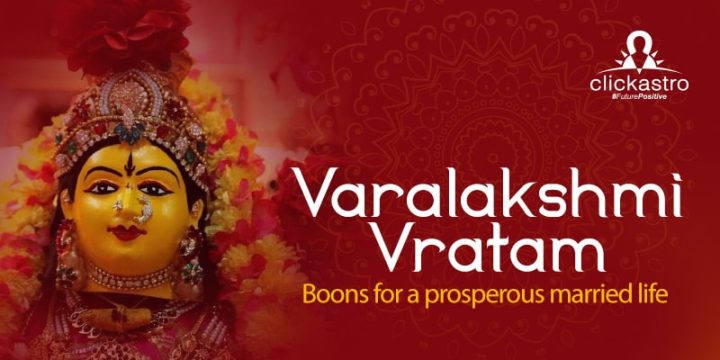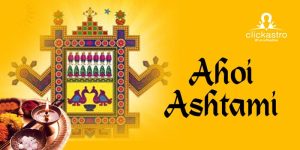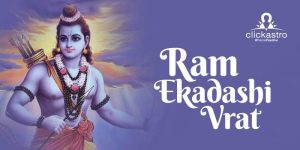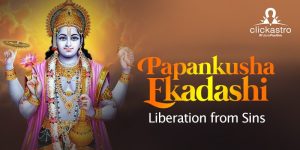Contents[hide]
Varalakshmi Vratam
India is a melting pot of various cultures, religions, and traditions. Every culture or religion has its specific fasts and festivities which hold great significance in the life of the devotees. One such festival is the Varalakshmi Vratham or Varalakshmi fast. Varalakshmi vratam, also referred to as Varalakshmi Pooja or Varalakshmi Nombu, is a Hindu festival honouring Goddess Lakshmi. Varalakshmi vratam, or fast, is mostly observed by married women to obtain graces from Varalakshmi, a manifestation of Goddess Lakshmi. Varalakshmi bestows ‘Var‘ or ‘Varam,’ which means boons. Varalakshmi vratam, also known as Varamahalakshmi vratham, is observed on the second Friday of Shravan month (Aadi month), just before the full moon (Purnima) On the English calendar, it coincides with the months of July or August. The Varalakshmi vratam is observed by married women to obtain blessings for their entire family, particularly for their spouse and children. Everyone is welcome to participate in this vratam, regardless of sex, caste, or creed. According to Hindu scriptures, worshipping Goddess Lakshmi on this auspicious day is equivalent to praying to Ashtalakshmi or the eight energies of Goddess Lakshmi i.e., Siri (Wealth), Bhu (Earth), Saraswati (Wisdom), Preeti (Love), Keerthi (Fame), Shanthi (Peace), Santhushti (contentment) and Pushti (Strength). The Hindus refer to all eight forces as the Ashta Lakshmis or the Eight Lakshmis. Get Your Free Marriage PredictionsAshta Lakshmis
- Aadi Lakshmi (the Protector)
- Dhana Lakshmi (Goddess of Wealth)
- Dhairya Lakshmi (Goddess of Courage)
- Sowbhagya Lakshmi (Goddess of Prosperity)
- Vijaya Lakshmi (Goddess of Victory)
- Dhanya Lakshmi (Goddess of Nourishment)
- Santaana Lakshmi (Goddess of Progeny)
- Vidya Lakshmi (Goddess of Wisdom
When is Varalakshmi Vratam in 2022?
This year, Varalakshmi Vratam will be observed on Friday, August 12.
Auspicious Timings for Varalakshmi Vrat
- Sunrise 6:05 AM on August 12, 2022
- Sunset 6:58 PM on August 12, 2022
- Purnima Tithi Commences 10:38 AM August 11, 2022
- Purnima Tithi Concludes 7:05 AM August 12, 2022
Varalakshmi Vratam 2022 Puja Timings
Varalakshmi Vratam Puja:
- Simha Lagna Puja Muhurat 6:14 AM to 8:31 AM on August 12, 2022
Duration 2 Hours 17 Mins - Vrishchika Lagna Puja Muhurat 1:07 PM to 3:25 PM on August 12, 2022
Duration 2 Hours 18 Mins - Kumbha Lagna Puja Muhurat 7:12 PM to 8:39 PM on August 12, 2022
Duration 1 Hour 27 Mins - Vrishabha Lagna Puja Muhurat 12:12 AM to 2:12 AM on August 13, 2022
Duration 2 Hours 00 Mins
Download Your Wealth Horoscope
Rituals performed for Varalakshmi Vratam:
Devotees commence the preparations for the Varalakshmi vratam one day prior to the vrat, which is a Thursday. On this day, all the necessary items for the vratam and puja are gathered. On the day of Varalakshmi vratam, Friday, devotees wake up early during the Brahma Muhurtham i.e., before dawn and prepare after taking a bath. This is also the auspicious time for performing the puja. Following the completion of the morning rituals, devotees tidy up their homes and surrounding area, and a beautiful kolam (rangoli) is decorated at the site of puja. The ‘Kalasha or Kalash’ must now be prepared. Devotees can choose between silver and bronze pots. The pots are cleaned thoroughly and smeared with sandalwood paste. The Kalasha is then inscribed with the swastika symbol. After that, the Kalasha is filled with water or raw rice, lime, coins, beetle nuts, and five diverse types of leaves. The items used for filling the Kalasha pot differ from region to region. In some places, the pot is filled with turmeric, black beads, a mirror, small black bangles, or a comb. The Kalasha’s neck is wrapped in a clean cloth, and the mouth is wrapped in mango leaves. Finally, a turmeric-dipped coconut is used to cover the Kalasha’s mouth. A picture of Goddess Lakshmi is stuck or drawn on the coconut with turmeric powder. The Kalasha is now revered as a symbol of Goddess Varalakshmi and is worshipped with pious dedication. This Kalasha is now installed on the rice heap. The goddess is offered flowers and gold which are kept in the front of the Kalash. Devotees begin the puja by worshipping Lord Ganesha. The puja commences with chanting slokas such as Lakshmi Sahasranamam praising Goddess Lakshmi. As an offering, special treats are made at home. Pongal is also served as Prasad in the southern states. Finally, the aarti on the Kalasha is performed. A sacred yellow thread or rakshai/saradu is tied around the wrists of the women during the puja. This is worn to represent protection and devotion, and several items are given in good faith as gifts and charity. This puja can be performed regardless of caste or creed. Many women still observe this traditional festival and pray to Varamahalakshmi for her blessings in the form of wealth and well-being for their families. In some regions, a mirror is sometimes placed behind the Kalasham. There are also readymade Kalasha pots available to use for the Varalakshmi Vrat puja. Women who observe Varalakshmi Vrat must refrain from consuming certain foods. This, however, varies by region. In some places, those who observe this vrat must fast until the end of the puja ceremony. The day after the puja i.e., on Saturday, the devotees bathe and then dismantle the puja, Kalasha. The water inside the Kalasha is sprinkled throughout the house, and the rice, if used, is mixed with rice stored in the house or used to prepare a rice meal or Prasad for the family the following day. Fasting entails abstaining from certain foods, which differ from region to region. There are no rules to follow in some areas. In some regions, women are offered Thamboolam — a combination of slaked lime, betel leaf, and areca nut. They perform Varalakshmi puja, in which women offer flowers, sweets, and fruits to the goddess, known as Vayana.The Legend behind Varalakshmi Vratham – Varalakshmi Vrat Katha
Legend has it that Lord Shiva directed that this pooja be undertaken by his consort Parvathi to bring prosperity and happiness to the family. Goddess Parvathi is said to have observed the fast for her beloved consort and the prosperity and happiness of her family, and it has since become a popular tradition for women across South India to observe the Varalakshmi Vratam on the Shukla Paksha of Shravana month. Women also prayed for the blessing of progeny. In some South Indian versions, it is believed that Goddess Meenakshi a renowned form of Goddess Parvathi famous performed this vratam to attain Lord Shiva as her husband. There are a few well-known stories associated with Varalakshmi Vratham. The stories of Charumati and Shyamabala are the most important among them all.Charumati and Vara Mahalakshmi
According to the Skanda Purana, Goddess Parvati once asked Lord Shiva about a vrata that would benefit women. Lord Shiva then emphasised the significance of Varalakshmi Vrata, the most beneficial Vrata for women. Lord Shiva told the story of Charumati to demonstrate the significance of the Varamahalakshmi Vrat. In the days of yore, there lived a woman named Charumathi in Kundinyapura, a town in the Magadha Kingdom. Pleased with Charumati’s devotion, Goddess Lakshmi appeared in her dream and asked her to perform the Varalakshmi Vratam. She explained to her the procedures of the Vratam and asked her to worship Varalakshmi and seek to fulfil her wishes. Varalakshmi is another form of Lakshmi, the goddess of wealth. Charumathi was instructed that the worship was to be offered on the Friday of Shravana month, preceding the full moon night. When Charumathi told her family about her dream, they encouraged her to perform the pooja. The devout Charumathi invited all her neighbours, friends, and relatives to perform the Varalakshmi puja as directed by Goddess Lakshmi. The other village women joined her in conducting the traditional puja and offering sweets to the Goddess Varalakshmi while chanting the sacred mantras. Soon after the puja, everyone who took part in it was bestowed with prosperity and abundance.Shyamabala and Varalakshmi Vrata
Shyamabala is another popular story associated with Varamahalakshmi Vratha. Shyamabala was the daughter of King Bathrasiravas and Queen Surachandrika. She married a prince from a neighbouring kingdom. While she was in her parents’ palace, Shyamabala once saw her mother, Queen Surachandrika, driving away an old lady. The old lady requested that the Queen perform Varalakshmi puja, but the queen did not appreciate a beggar advising her on pujas and thus drove her out. The kind-hearted Shyamabala invited the old lady and listened to Varalakshmi Vratam’s greatness. She returned to her homeland and performed the Vratam as instructed by the old lady. Her kingdom soon began to prosper, and the prince was praised for his wise leadership. However, Shyamabala’s parents had to endure countless sufferings, and there was hardship all around. The king and queen lost all their wealth, and the people began to revolt against their rule. Shyamabala sent gold pots to her parents’ kingdom after hearing about their suffering, but the moment Queen Surachandrika saw them, they turned to ashes. When Shyamabala heard this, she realised it was all the result of her mother driving the old woman out of the palace. She realised the old woman was Goddess Lakshmi in disguise. Shyamabala then requested that her mother pray to Goddess Lakshmi and perform the Varalakshmi Vratam. Queen Surachandrika did so and was able to reclaim her former glory.The Curse of Chitranemi
Another story in the Hindu scriptures associates the origin of Varalakshmi Vratha with a dice game between Lord Shiva and Parvati. Lord Shiva accused Goddess Parvati of cheating because she was winning all the games. As a result, they decided to appoint Chitranemi, a Shiva gana, as the referee. Chitranemi ruled in favour of Lord Shiva, which enraged Goddess Parvati, who cursed him with leprosy. Shiva begged Parvati to forgive Chitranemi, and she agreed to lift the curse if he saw Varalakshmi Vratha performed by devout women. Varalakshmi Vratha became a tradition from then on.Significance of Varalakshmi Vratham
The primary goal of Varalaksmi Vratam is to offer sincere prayers to Goddess Lakshmi to obtain divine blessings. There are no fixed rules for keeping this vrat. The rituals are not strict, and simple prayer is sufficient to appease Goddess Varalakshmi. Goddess Lakshmi is the Hindu mythological deity of prosperity, wealth, fortune, wisdom, light, generosity, courage, and fertility. Lord Vishnu serves as a refuge for the Ashtalakshmis or forces. Goddess Lakshmi is the personification and reverence of these forces. The festival is mostly observed by women, who invoke Lakshmi’s blessings on themselves, their husbands, and their children. This vrat is performed by women, particularly married women, to please Goddess Lakshmi and receive Her divine grace. The women pray to the Goddess for the longevity of their husbands, as well as for good progeny. Varalakshmi vratam is primarily a women’s festival and is only observed by women. The Skanda Purana explains the importance of Varalakshmi vratam.Varalakshmi Vrat festival dates between 2022 and 2026
| Year | Day | Date |
| 2022 | Friday | 12th August 2022 |
| 2023 | Friday | 25th August 2023 |
| 2024 | Friday | 16th August 2024 |
| 2025 | Friday | 8th August 2025 |
| 2026 | Friday | 28th August 2026 |
Mantra to Chant
To invoke the blessings of Goddess Lakshmi, a mantra must be recited on the day of Varalakshmi Vrat.||Padmaasane Padmakare ||(Meaning – She who sits in the lotus, she who holds the lotus to whom all the worlds pray Goddess who is dear to Narayana be kind/good to me)
||Sarva Lokaika Poojithe ||
||Narayanapriya Devi ||
||Supreethaa Bhava Sarvada ||







